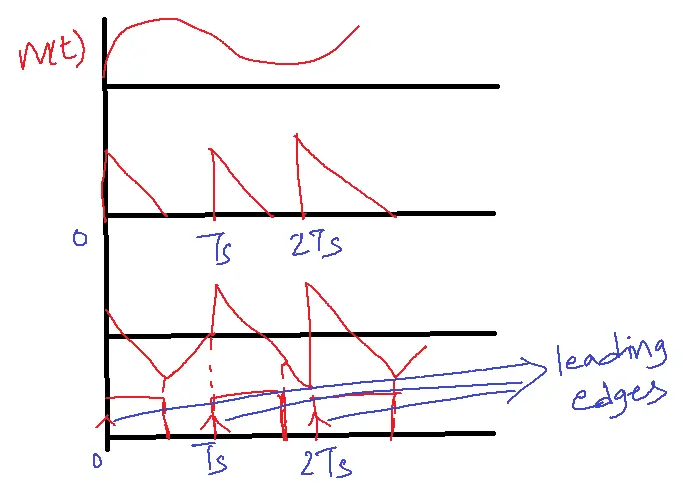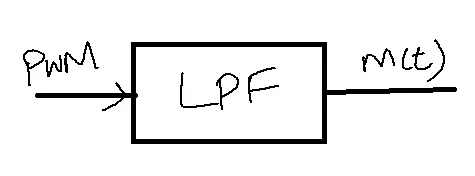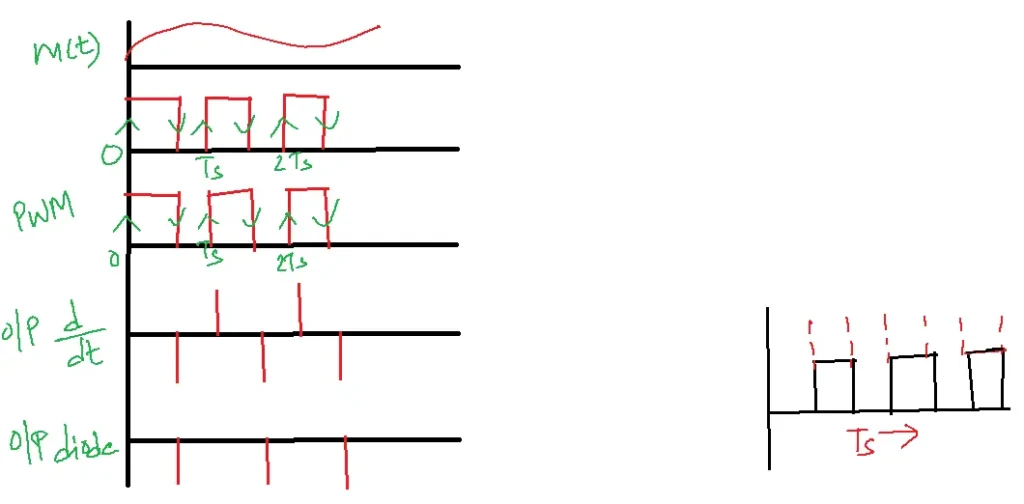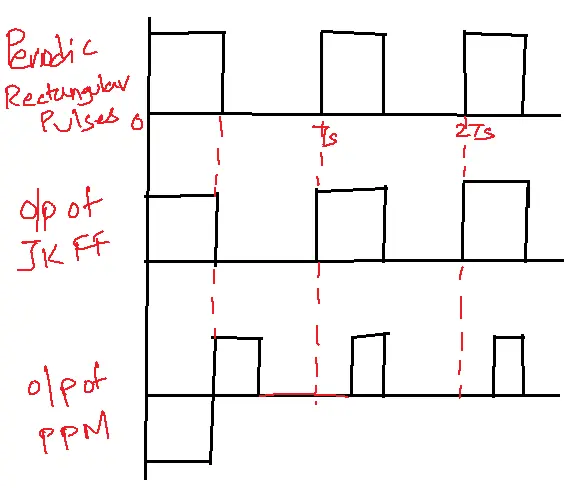In the pulse width modulation method, the pulse width is varied according to the sampled value.
In the pulse position modulation method, the position of pulses is varied according to the sample value.
In Pulse Width Modulation (PWM), the width of a constant-amplitude pulse is directly modulated by the amplitude of the sampled analog signal. It’s sometimes known as pulse length modulation (PLM) or pulse duration modulation (PDM). Its straightforward synthesis makes it a common choice in digital circuits, particularly for class-D audio amplifiers and voltage regulators.
Table of Contents
Generation of PWM signals:
In this pulse width modulation method, the message signal and periodic signal are added to the thermal voltage signal and applied to a slicer or comparator. The input to the slicer is compared to Vth to determine the output signal.
High Voltage means the input voltage is greater than the thermal voltage.
Low voltage means the input voltage is less than the thermal voltage.

In pulse width modulation method waveforms, leading edges are located at 0, Ts, 2Ts, and 3Ts.

The position of the trailing edge is varied to change the pulse width.
The pulse width changes so that the bandwidth of the pulse width modulation signal is not constant. The power required to transmit the signal is not constant, and the pulse width changes.
Demodulation of PWM Signals:
PWM signal is passed through LPF for demodulation.

Applications of Pulse Width Modulation
- Motor Control: PWM is a cornerstone of motor control systems. By varying the pulse width, engineers can precisely control the speed and torque of DC and AC motors, making it essential for industrial automation, robotics, and electric vehicles.
- Power Electronics: In the field of power electronics, PWM is a prevalent technique for achieving efficient voltage and current regulation. It enables the conversion of DC voltage to variable AC voltage (inverters) and vice-versa (rectifiers), crucial for power supplies, renewable energy systems, and motor drives.
- LED Dimming: PWM is the go-to method for dimming LEDs. By rapidly switching the LEDs on and off, the perceived brightness can be adjusted while maintaining energy efficiency, making it ideal for lighting applications in homes, offices, and displays.
- Audio Amplifiers: PWM is employed in Class-D audio amplifiers for high efficiency and low heat generation. It converts the audio signal into a series of pulses, allowing for compact and powerful audio systems in consumer electronics and professional audio equipment.
- Communication Systems: PWM finds application in communication systems for transmitting information. It can be used for encoding data in pulse width variations, enabling communication over various channels, including power lines and optical fibers.
Pulse Position Modulation (PPM):
In this pulse position modulation method, the position of the pulses is varied according to the sampled value. The amplitude and pulse width are the same before modulation and after modulation.
The amplitude of the sampled analog signal controls the placement of a constant-width pulse within its allocated time slot.
Because multipath fading is negligible, it is frequently employed in communications across optic fibers. Because demodulation is simple and enables a low-cost receiver, it is also utilized in communications for remote control cars, aircraft, and other vehicles.

The message signal and periodic pulses are applied as input to the PWM modulator. The generated PWM( pulse width modulation) signal is applied as input to the PPM modulator. The differentiator generates positive spikes at leading edges and negative spikes at trailing edges.
The positive spikes are clipped using the diode. The mono-stable multivibrator utilizes the negative spikes as triggering pulses. The output represents the pulse position modulation signal.
Pulse position modulation’s popularity stems from its ability to maintain constant bandwidth and power by keeping pulse width and amplitude fixed.

Demodulation of PPM:

PPM is converted into a PWM signal using a JK flip-flop. The PWM signal is demodulated using a low pass filter. Periodic rectangular pulses are applied as input to J and PPM signal is applied as input to K.

Comparison between PAM, PWM, and PPM:
| Category | PAM | PWM | PPM |
| Amplitude | Not Constant | Constant | Constant |
| Pulse Width | Constant | Not Constant | Constant |
| Power | Not Constant | Not Constant | Constant |
| Bandwidth | Constant | Not Constant | Constant |
| Complexity | Very low | Medium | High |
Applications of Pulse Position Modulation
- Optical Communication Systems: PPM is widely used in optical communication systems, especially for long-distance transmission. It offers advantages like high noise immunity and efficient use of power, making it suitable for fiber-optic networks and satellite communication.
- Remote Control Systems: PPM is a commonly used modulation scheme for encoding signals in remote control systems. It’s used in devices like drones, model airplanes, and industrial control systems, where precise control and reliable communication are essential.
- Ultra-Wideband (UWB) Systems: PPM plays a key role in UWB technology, enabling high-speed data transmission with low power consumption. This makes it attractive for applications like wireless sensor networks, indoor positioning systems, and short-range radar.
- Military and Aerospace Applications: PPM is leveraged in diverse military and aerospace systems, including secure communications, radar, and telemetry. Its resistance to jamming and interception makes it suitable for these critical applications.
- Biomedical Instrumentation: PPM has potential applications in biomedical instrumentation for measuring physiological parameters like heart rate and blood pressure. Its ability to transmit information with minimal interference makes it a valuable tool in medical devices.
FAQs of Pulse Width Modulation and Pulse Position Modulation
1. What is Pulse Width Modulation (PWM)?
- Pulse Width Modulation (PWM) is a technique that modifies the duration of a pulse signal to mirror the amplitude changes in the message signal.
- It’s widely used for controlling power, dimming LEDs, and generating analog signals from digital devices.
2. What is Pulse Position Modulation (PPM)?
- In Pulse Position Modulation (PPM), the timing of a pulse is adjusted relative to its standard position, directly corresponding to the amplitude of the message signal being transmitted.
- It’s known for its noise immunity and is used in optical communication, remote control systems, and UWB technology.
3. What are the key differences between PWM and PPM?
- PWM: Varies pulse width, constant amplitude, and position.
- PPM: Varies pulse position, constant amplitude, and width.
- Applications: PWM is often used for power control and analog signal generation, while PPM is preferred for communication systems and precise timing control.
4. What are the advantages of PWM?
- Efficient power control
- Simple implementation
- Applicable to a broad spectrum of domains, notably motor control, power electronics, and LED dimming systems.
- It can be generated using digital circuits (e.g., microcontrollers).
5. What are the advantages of PPM?
- High noise immunity
- Efficient power usage
- Suitable for long-distance communication (e.g., optical fibers)
- Precise timing control in remote control and UWB systems.
6. What are the challenges of using PWM and PPM?
- PWM: Can generate electromagnetic interference (EMI) due to rapid switching.
- PPM: Requires synchronization between transmitter and receiver for accurate decoding.
